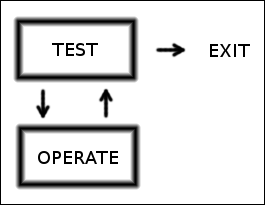User:Elmidae/T.O.T.E.
The T.O.T.E. or TOTE, standing for "Test - Operate - Test - Exit", is an iterative problem solving strategy based on feedback loops. It was described by George A. Miller, Eugene Galanter, and Karl H. Pribram in their 1960 book, Plans and the Structure of Behavior which outlined their conception of cognitive psychology.
Background

By 1960, psychology had come to be dominated by behaviorism and learning theory, which emphasized the observable stimulus and response components of human and animal behavior while ignoring the cognitive processes that mediate the relationship between the stimulus and response. The cognitive phenomena occurring within the "black box" between stimulus and response were of little interest to behaviorists, as their mathematical models worked without them. In 1960, the book Plans and the Structure of Behavior, authored by George A. Miller, Eugene Galanter, and Karl H. Pribram, was published. In this volume, Miller and his colleagues sought to unify the behaviorists' learning theory with a cognitive model of learned behavior. Whereas the behaviorists suggested that a simple reflex arc underlies the acquisition of the stimulus-response relationship, Miller and his colleagues proposed that "some mediating organization of experience is necessary" somewhere between the stimulus and response, in effect a cognitive process which must include monitoring devices that control the acquisition of the stimulus-response relationship. They named this fundamental unit of behavior the T.O.T.E.
The TOTE Unit in Human Cognition
The self-control mechanisms in human tasking are explained in terms of both operations and monitoring processes. Each recurring operation would be associated to a monitoring process, to test if the intended control was yes or not.
Its premise is that a common algorithm for solving non-deterministic problems in a complex system, is to test where the system is currently, then perform some operation that makes a change, then retest again, and to repeat this until the answer is satisfactory, at which point the process is complete and ends (or exits).
The generic TOTE structure is:
- Test to obtain some representation of the problem state
- Operate - intervene in some way
- Test again to see if the desired result has been achieved. If it has not, loop back to operate. If it has:
- Exit - problem solved
TOTEs are often nested within other TOTEs, since as a means to meet a goal, they are applicable to sub-goals too.
TOTE units commonly used in many disciplines where iterative methods are applicable, such as engineering, artificial intelligence, and cybernetics. In psychology, it is explicitly used as a key strategy within neuro-linguistic programming.
Central to the concept of the TOTE unit are the following principles:
- Planning, consisting of TOTE units, is essential in cognitive process.
- Control of behavior exposes a set of chunks and TOTE units
Examples
The following is an example of a simple TOTE: When driving a car and looking for the appropriate turn off.
- Test - is this the turnoff? - No
- Operate - keep driving
- Test - is this the turnoff? - No
- Operate - keep driving
- Test - is this the turnoff? - Yes
- Exit
(this only finds the correct turnoff, and would be embedded in a larger TOTE)
A TOTE can also be nested within other TOTEs, for example: Cooking a meal:
- The top level TOTE for "testing if meal is cooked" is:
- Check meal—leave a while—recheck meal - take out of oven.
- As part of the "leave a while" part, there is a nested TOTE:
- Check if 5 minutes is up—wait a while—recheck if 5 minutes is up—exit (ie "leave a while" subgoal is achieved)
External links
- An article by George A. Miller on T.O.T.E. and Information Processing Theory
See also
References
- Miller, GA, Galanter, E., & Pribram, KA (1960). Plans and the structure of behavior. New York: Holt, Rhinehart, & Winston.
